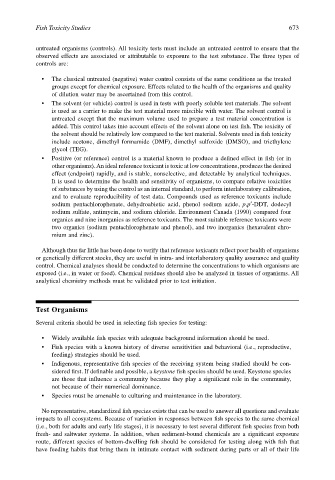Page 693 - The Toxicology of Fishes
P. 693
Fish Toxicity Studies 673
untreated organisms (controls). All toxicity tests must include an untreated control to ensure that the
observed effects are associated or attributable to exposure to the test substance. The three types of
controls are:
• The classical untreated (negative) water control consists of the same conditions as the treated
groups except for chemical exposure. Effects related to the health of the organisms and quality
of dilution water may be ascertained from this control.
• The solvent (or vehicle) control is used in tests with poorly soluble test materials. The solvent
is used as a carrier to make the test material more miscible with water. The solvent control is
untreated except that the maximum volume used to prepare a test material concentration is
added. This control takes into account effects of the solvent alone on test fish. The toxicity of
the solvent should be relatively low compared to the test material. Solvents used in fish toxicity
include acetone, dimethyl formamide (DMF), dimethyl sulfoxide (DMSO), and triethylene
glycol (TEG).
• Positive (or reference) control is a material known to produce a defined effect in fish (or in
other organisms). An ideal reference toxicant is toxic at low concentrations, produces the desired
effect (endpoint) rapidly, and is stable, nonselective, and detectable by analytical techniques.
It is used to determine the health and sensitivity of organisms, to compare relative toxicities
of substances by using the control as an internal standard, to perform interlaboratory calibration,
and to evaluate reproducibility of test data. Compounds used as reference toxicants include
sodium pentachlorophenate, dehydroabietic acid, phenol sodium azide, p,p′-DDT, dodecyl
sodium sulfate, antimycin, and sodium chloride. Environment Canada (1990) compared four
organics and nine inorganics as reference toxicants. The most suitable reference toxicants were
two organics (sodium pentachlorophenate and phenol), and two inorganics (hexavalent chro-
mium and zinc).
Although thus far little has been done to verify that reference toxicants reflect poor health of organisms
or genetically different stocks, they are useful in intra- and interlaboratory quality assurance and quality
control. Chemical analyses should be conducted to determine the concentrations to which organisms are
exposed (i.e., in water or food). Chemical residues should also be analyzed in tissues of organisms. All
analytical chemistry methods must be validated prior to test initiation.
Test Organisms
Several criteria should be used in selecting fish species for testing:
• Widely available fish species with adequate background information should be used.
• Fish species with a known history of diverse sensitivities and behavioral (i.e., reproductive,
feeding) strategies should be used.
• Indigenous, representative fish species of the receiving system being studied should be con-
sidered first. If definable and possible, a keystone fish species should be used. Keystone species
are those that influence a community because they play a significant role in the community,
not because of their numerical dominance.
• Species must be amenable to culturing and maintenance in the laboratory.
No representative, standardized fish species exists that can be used to answer all questions and evaluate
impacts to all ecosystems. Because of variation in responses between fish species to the same chemical
(i.e., both for adults and early life stages), it is necessary to test several different fish species from both
fresh- and saltwater systems. In addition, when sediment-bound chemicals are a significant exposure
route, different species of bottom-dwelling fish should be considered for testing along with fish that
have feeding habits that bring them in intimate contact with sediment during parts or all of their life

